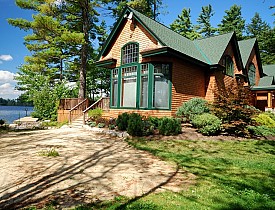Caring for Conifers
 Conifers, the group of trees made up primarily of spruce, fir, pine and hemlock, are an attractive and long-lasting addition to any landscape. Conifers naturally provide the bonus of evergreen color, which can serve as a backdrop or simple visual relief in a stark landscape. Conifers may be used in a number of creative ways as hedges and in rock gardens.
Conifers, the group of trees made up primarily of spruce, fir, pine and hemlock, are an attractive and long-lasting addition to any landscape. Conifers naturally provide the bonus of evergreen color, which can serve as a backdrop or simple visual relief in a stark landscape. Conifers may be used in a number of creative ways as hedges and in rock gardens.
How do you get started planting and working with conifers? In an interview several years before his passing, the late Robert Childs, of the University of Massachusetts Extension Service, shared his knowledge on how best to care for conifers.
Before You Buy
Childs advised that the first thing you want to do is find a reputable nursery. Second on the list is having your soil tested. “Everybody forgets about the soil. Most conifers prefer a soil that is slightly acidic.” According to Childs, when conifers do drop their needles, they help to provide needed soil acidity without overwhelming the tree.
Also, be sure you know what planting zone you are in. For instance, conifers that would thrive on Long Island, NY (Zone 7), would not be able to tolerate the intense level of cold in Massachusetts (Zone 5). “Every tree has its own set of needs,” pointed out Childs. “Plant the right tree in the right place.”
Childs also cited a basic rule of thumb about conifers: most do not like wet soils. Research the type of conifer you want to plant. Childs gives as an example the salt sensitivity of White Pines. “You wouldn’t want to plant them next to a major road or the salt run-off in the winter will kill them. Whereas the Pitch Pine you’ll find on the Cape [Cod] is very salt tolerant.”
Tips When Planting Conifers
“Trees that are transplanted are under stress for up to two years. You can’t just plant them and walk away,” warned Childs, adding that the most important factor in transplanting conifers is how the root system is cared for. “Large nurseries may be digging up tens of thousands of trees with machinery. Some trees may not come out with a healthy root system. You want to have maximum root development. Trees lose up to 95 percent of their roots when being transplanted.”
Childs recommended fall as the best time to transplant conifers. Once you have your trees ready for planting, take the burlap, wire, or bucket off the plant and examine the roots. Plant the tree only up to the root flare or you risk killing it. The root flare is the point where the roots begin to flare out from the trunk. “Sometimes the flare ends up in the middle of that root ball,” cautioned Childs. “Take off as much wrapping as possible and really examine what you have.”
Make sure your conifers receive adequate water following planting, especially when there is a drought.
Childs claimed that “unless it's incredibly poor soil, you shouldn’t have to use peat, compost, or manure to fertilize" and only in the worst soil conditions should a fertilizer such as a 10-10-10 mix be used.
What insects are conifers susceptible to, and what do I do about them?
Conifers don’t tend to be especially attractive to insect infestations with a few notable exceptions. Mugo, or dwarf mountain pines, are susceptible to caterpillar infestations. Mugo pines are often used as ornamentals around rock gardens as they are low-lying.
Some conifers are vulnerable to pine needle scale and spider mites, and hemlocks may attract wooly adelgid, which was introduced to the northeastern US in the 1950’s. Wooly adelgid are fluid-sucking insects similar to aphids. “It has weakened a lot of trees and can kill them,” stated Childs. Do not fertilize with nitrogen-containing products if you have wooly adelgid, as they thrive on nitrogen.
There are many pesticides approved for homeowner use, some of which are earth-friendly such as horticultural oils and insecticide soaps. However, you may want to call in a professional if the problem gets out of hand. You also may need to take out any diseased/infested trees so that any others around them have a better chance for survival.
What about pruning?
Due to the fact that the conifers you are transplanting have been stressed by the process, avoid heavy pruning initially. “You shouldn’t prune at planting unless you have broken or damaged limbs,” according to Childs. “The foliage and roots ‘talk’ to each other via hormones.” The communication process that goes on between roots and foliage lets the tree know it needs more water or certain types of nourishment.
Now you have the basics on conifer care. To find additional information regarding which conifers will work best in your location, it is best to hire a savvy local landscaper or talk with people at nearby nurseries.
Updated July 29, 2018.
Looking for a Pro? Call us (866) 441-6648

Landscaping Average Costs
Landscapers Experiences

Fast Professional Tree Service For My Crabapple And Persimmon

Concrete Patio Is The Finishing Touch For An Artist's Studio



